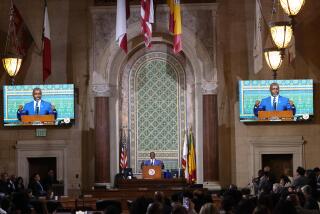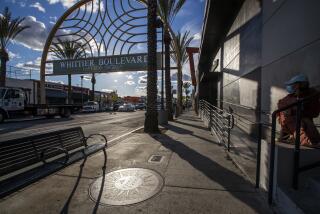Big Welcome for ‘President of Harlem’
- Share via
NEW YORK — There was a big party Monday in Harlem for Bill Clinton, a sort of Elvis-is-back event with speeches, dignitaries and loud music to welcome the man who 125th Street will always consider the president.
Clinton officially moved into his office on the top floor of an old brick high-rise and unofficially launched his post-White House career in a city that knows how to adopt a celebrity.
For the record:
12:00 a.m. Aug. 3, 2001 FOR THE RECORD
Los Angeles Times Friday August 3, 2001 Home Edition Part A Part A Page 2 A2 Desk 1 inches; 26 words Type of Material: Correction
Clinton office--A front-page story Tuesday on former President Clinton opening his office in Harlem misspelled the name of the singer who popularized “Stand by Me.” He is Ben E. King.
What Clinton gets from Harlem is a light-filled office with cherry wood-trimmed bookshelves, 8,608 square feet of space and a break on the rent--$31.50 a square foot versus the $89 he was criticized for wanting to pay for a suite above Carnegie Hall on 57th Street.
And as he writes his memoirs, the former president will have a spectacular view of Harlem’s church spires and across Central Park for four miles to Manhattan’s midtown skyscrapers.
That view of the other Manhattan, of a commercial world that remains suspicious of the newly invigorated Harlem and sees it still as a ghetto, raises a complicated question for the former president.
For while New York, particularly Harlem, is eager to embrace Clinton, the question in this historic but beleaguered black community is: What will Clinton do for Harlem?
Can he persuade skeptical Fortune 500 directors, for example, to rent cheap in Harlem? Can he charm foreigners into investing in an area that has seen a retail revival but little commercial construction?
There has not been a new office tower in Harlem since 1972, when Richard Nixon was president and a black Republican developer put up the one Clinton now will occupy.
After apologizing that his wife, Hillary Rodham Clinton, New York’s junior senator, could not attend because her mother was undergoing colon cancer surgery in Washington, Clinton pledged to do good for the community that stood by him during the worst times of his presidency.
“You were always there for me and I will try to be there for you,” he said at a ceremony down the street from his new office. When Benny King’s jazz group started playing “Stand by Me” after Clinton’s 10-minute speech, he sang along exuberantly and nearly leaped across the stage to be near the musicians.
“Oh I love that man,” shouted Barbara Sapp as she, too, sang out with the boogieing president in his bright blue tie and dark suit.
For many like Sapp, a retired teacher, and Sophie Little, who works for the IRS in Clinton’s building, it will be enough if he just shows up from time to time in Harlem and is photographed there by the tabloids, beaming his generous smile.
“He’s still the first black president,” Little said, acknowledging a common street wisdom.
There also is reluctant affection for Clinton among New York’s white elite. While many objected to Clinton’s Oval Office womanizing and questioned many of his last-minute pardons, they still clamor for him at their dinner parties.
“I think he’s going to charm the birds right out of the trees,” said David Patrick Columbia, who writes for the well-read Web site, https://www.newyorksocialdiary.com. “I know certain unnamed hostesses are giving him dinners in September. I know they’re hot tickets.”
Darren Walker has more ambitions for what it could mean to have the 42nd president in the neighborhood.
“We’re on the cusp of something really great in Harlem,” said Walker, an ex-Wall Street bond salesman who now works out of the crummy basement office of the Abyssinian Development Corp., which is trying to rejuvenate central Harlem for its 100,000 residents.
“Clinton is not going to sell Harlem as a corporate office center,” Walker said. “But he can validate the area. He can help our image.”
But Harlem businessmen are eager for Clinton to attract corporations to relocate uptown instead of, for example, across the Hudson River in New Jersey. And they hope that when dignitaries such as Clinton’s good friend British Prime Minister Tony Blair come to town, they’ll meet in Harlem rather than in some presidential suite near the United Nations.
In just the last few years, residents say, Harlem has experienced a second renaissance and has the potential to equal the glories of the 1920s and 1930s, when it enjoyed high culture with prominent residents such as writer Langston Hughes and the glamorous night life of black entertainers in white-owned clubs.
Al Harvin, a retired sportswriter, reminisced about those heady times before riots and drug wars turned Harlem into a slum.
“There was more culture here than you could ever know. It was a place where black people lived decent lives.”
Although he is pleased to have Clinton as a neighbor, Harvin and others also worry about Harlem losing its character to gentrification, with rising rents and multiplying chain stores. That was the subject of protests Monday by a handful of members of the New Black Panther Party who tried unsuccessfully to disrupt the speakers.
Democratic Rep. Charles B. Rangel, who represents the Harlem area and who first suggested that Clinton move here, even joked about the dozen protesters with their fists in the air: “I want to thank my Republican friends for sponsoring this group. . . . They’re clearly from Washington, not from here.”
“Get a life and get a job,” retired teacher Sapp shouted at them.
Helped along by an economic boom and hundreds of millions of dollars in government aide, Harlem’s thoroughfares indeed have come back. It’s not just an occasional Starbucks or a new grocery store or spruced-up awnings on old storefronts. Crime and unemployment are down and theater renovations and a huge mall are on the drawing board. There also are busloads of German tourists coming for fried chicken and collard greens.
“Is it Beverly Hills? No. It ain’t even West L.A. But we’re definitely on our way to something better,” Walker said.
Harlem residents see the former president pushing the neighborhood further and faster. They look to the day, for example, when Clinton, if he wants to buy a bestseller at lunchtime, can get titles other than about African Americans; if he wants sushi or risotto he doesn’t have to go downtown to get it; if he wants to pick up a present at Ann Taylor for his daughter, he won’t have to drive to Westchester County where he and his wife own a home.
What would be good for Clinton would be good for Harlem: hotels and high-rise buildings that would give the neighborhood and its residents the boost they want.
Teacher Mark DeGennera has a decorating suggestion for the wall in Clinton’s office: a poem by writer Hughes “as a reminder of the people 14 stories below who need him.” He recited the lines: “So we stand here / On the edge of hell / In Harlem / And look out on the world / And wonder / What we’re gonna do / In the face of what/We remember.”
More to Read
Sign up for Essential California
The most important California stories and recommendations in your inbox every morning.
You may occasionally receive promotional content from the Los Angeles Times.













